'And He Was Carrying Fire' - Writers Researching...
This is an adaptation of a talk I gave recently at the Birmingham Midlands Institute,
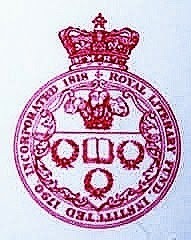 The Royal Literary Fundfor the Royal Literary Fund's programme of talks open to the public. I was one of three writers - the others were Jane Bingham and Mike Harris.
The Royal Literary Fundfor the Royal Literary Fund's programme of talks open to the public. I was one of three writers - the others were Jane Bingham and Mike Harris.I wish I could give an account of their talks, as they were fascinating and opened up many questions for discussion - but, as I was in the thick of it, so to speak, I couldn't make notes.
The panel was about 'Research for Writers.'
I have heard other writers talk of hours in the archives, or interviewing experts — not for me. Mostly I make it up.
Take my Sterkarms books —
These are sci-fi/fantasy/historicals… Part of them is set in the 21st Century, most of them in the early 16th, on the Scots Borders.
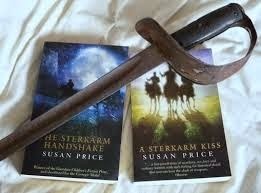
I did research them, but not in the 'hours in the library' sense.
More in the ‘getting sodden and cold on Scottish hillsides’ sense.
I first had the idea for the books while on a walking holiday along Hadrian's Wall, where I kept hearing mention of the Rievers. I then read MacdonaldFraser's Steel Bonnets and Godfrey Watson's Border Rievers, both of which are excellent sources of information about the rievers.
But does this count as research? I would have read these books anyway, from general interest. The fact that I used them, later, as reference was just – lucky.
When I have what I feel is a good idea for a book, I’m usually too impatient to begin writing to waste time researching. After all, I write fiction. I make it up. When I wrote the 16th Century sections of the Sterkarm books I relied on what I remembered from the books I'd read on the rievers, what I knew from general reading about the period, and a lot of educated guessing.
My approach has always been, 'If I was on the Borders in 1520 and had only the materials available that they had, and I wanted to do X, Y, Z — how would I solve that problem? And, I figure, if I could think of that solution, they did too.
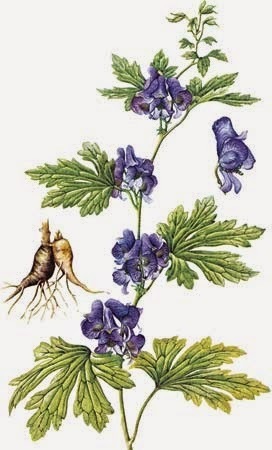 Wolfsbane: beautiful and lethal For instance, one of my characters, a bit of a witch, makes a painkiller by mixing wolfsbane with fat — not baby’s fat, just dripping. How would she store this lethal stuff? (Wolfsbane, AKA monkshood or aconite, is extremely poisonous in its every part - root, leaf, stem and flower. It's said that even the scent of its flowers in a room can make people ill.) My witch doesn’t have any Tupperware, she lives in the middle of nowhere, and I imagine even the crudest pots are an expense she'd find it hard to meet.
Wolfsbane: beautiful and lethal For instance, one of my characters, a bit of a witch, makes a painkiller by mixing wolfsbane with fat — not baby’s fat, just dripping. How would she store this lethal stuff? (Wolfsbane, AKA monkshood or aconite, is extremely poisonous in its every part - root, leaf, stem and flower. It's said that even the scent of its flowers in a room can make people ill.) My witch doesn’t have any Tupperware, she lives in the middle of nowhere, and I imagine even the crudest pots are an expense she'd find it hard to meet.In thinking about what she’d have available, I thought of mouse-nibbled hazel-nuts. I said she scraped her ointment into the hollow nuts and sealed them with wax.
Prove me wrong. Prove that no woman anywhere, anywhen, ever did that. You can't, can yer?
Making up my own answers, like this, means I can leave research until later while I go on sorting out my plot. In my experience, a new finding from research rarely ruins your plot — at most, it will need a few tweaks.
But endless, perfectionist research will prevent you from ever writing your book.
In any case, a lot of what I want to know can’t be found in books or archives.
What is it like to use a longbow? — Again, I owned a longbow long before I came to describe its use, because I'd always wanted to use a longbow.
What is it like to ride a horse? — I took a week-long riding course in Northumbria, where I learned how to fall off a horse.
What is like to sleep in one of those little cupboard beds, with a hay-filled mattress supported on ropes? — I sneaked into one in an Orkney museum when no one was around and found out.
You can't really find out about any of these things by researching in a library. You can read what others have written about them, but it won't give you the experience of drawing back the weight of a longbow, the personality of a horse, the smell of old grass and wood in the wall-bed.
I've also found that some of the most interesting, useful details are discovered when I'm not researching at all.
For instance, I wondered how my rievers would make fires - especially when they were travelling on raids. How did they light fires at home in the pele tower? I knew they wouldn't have had matches, but doubted that they spent much time rubbing sticks together. I researched in the usual way and the answer, of course, was tinderboxes.
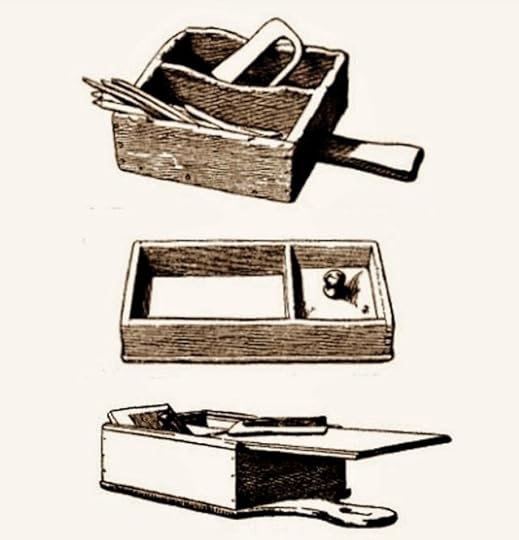 English tinderboxes, 18th-19th century (Wikimedia commons)
English tinderboxes, 18th-19th century (Wikimedia commons) When I used to read Andersen's 'Tinderbox' as a child, I had a vague idea that it was something like a modern lighter, that somehow made a flame by itself. In reality, it was a box where you kept all your fire-making equipment together in one place. It 'kept your tinder dry' and you always knew where to find the things you needed.
There was the firesteel. In the picture below, this is at the bottom. It is shaped to fit round the hand, to make it easier to use.
There was the flint - seen in the top right-hand corner. It might not actually be a flint, but a piece of any hard stone, which would create a spark when struck on the steel.
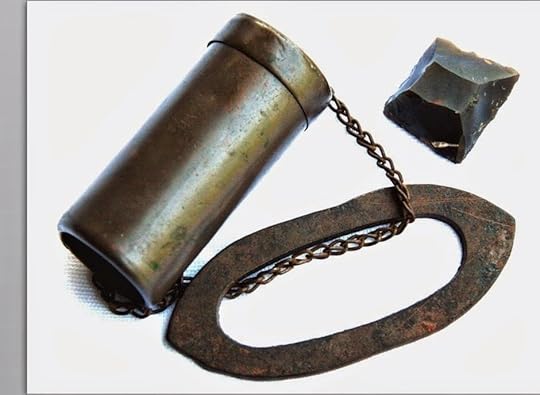
And then there was the tinder, which you kept dry in the box. This might be pieces of charred cloth, very dry plant material, or 'punk' which was the dry, powdery rotted wood from the centre of a dead tree.
You struck sparks from the steel with the flint, and let them fall on the tinder in the box — and when a spark started to smoulder, you blew on it until you had a flame. You lit one of your spills in the flame and transferred the flame to a candle, or to the kindling for your fire…
Most of the information I could find was of 18th or 19th century tinderboxes, but they were certainly used earlier — because here's Joseph striking a light for the Holy Family…
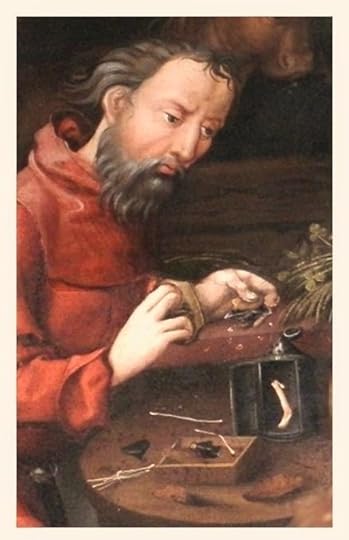
In this detail (below), you can see that St. Joe has the fingers of his right hand through the steel, and is holding the flint in his left. His tinder box is under the flint, ready to catch the flame. He has spills scattered around, ready to light at the flame when it catches. And under his left hand is an open lantern, holding a somewhat bent candle. He will light the candle from the lit spill.
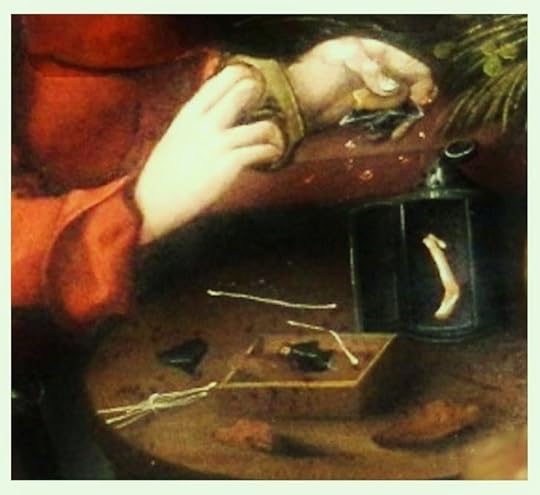
People used to have small tinder-boxes they could carry with them. So that's what I found out by what you might call 'formal research.' And I'm glad to know it. You never know when information on tinderboxes will come in useful. Which is why I'm keeping it all in my Research File.
However, it never seemed quite right to me for the rievers. I knew that people carried fire with them — I'd heard of fire being carried out to field, or about castles in 'fire-pots.' I know from family gossip that, more recently, one neighbour would help another out by carrying a shovel-full of hot coals from one house to another.
Carrying a fire-pot of hot coals on horseback seemed unlikely, though. Especially if, like the reivers, you never knew when you were going to have to gallop for your life.
Then, I read No Country For Old Men, by Cormac Macarthy. This had nothing to do with any research. I read the book purely because I wanted to.
In the book, the elderly narrator has a dream where he's riding at dusk, and sees his dead father ride past him on horseback and ride on ahead of him into the darkness. The narrator says, ‘and he was carrying fire.’
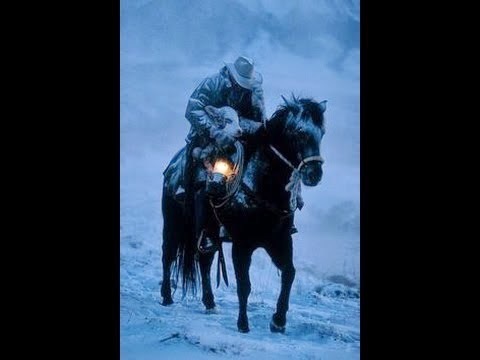 'carrying fire'
'carrying fire'The phrase about carrying fire seemed to carry a lot of weight, but I didn't understand it, or its significance. I puzzled about it quite a lot. Was I to imagine the father carrying a crown of fire on his head, like something out of William Blake, or a flaming torch, or what?
Then, on-line, I came across a forum where people were discussing the book and the Coen Brothers film of it. A lot of other people seemed puzzled by 'and he was carrying fire,' too.
Another poster explained it. He introduced himself (I assume it was 'him') as a survivalist, who had researched the old ways of life, before the arrival of electricity and the internet. The significance of 'and he was carrying fire' is that the narrator, an elderly man, dreams of his dead father riding on ahead of him into the dark. The father is carrying glowing embers in a cow-horn at his belt, so that he can make camp somewhere up ahead and wait for the narrator to join him. This is what used to be done 'on the trail' - one man would go ahead, with fire, make camp and have a fire burning ready for when the others joined him. So the phrase is a rather beautiful dream metaphor for the elderly narrator facing death. His father, he feels, will be waiting for him, somewhere up ahead in the dark, sitting beside a campfire.
The survivalist went on to explain how carrying fire was done. You took a hollow
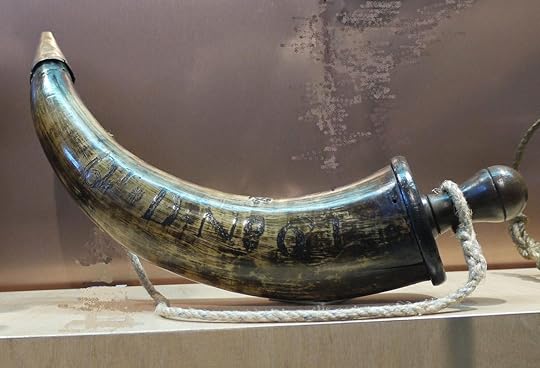 cow’s horn, and made a lid for it, from metal or leather, or horn. The lid had to be pierced, to let in the air. The horn also had a strap, so it could be carried at a belt or saddle.
cow’s horn, and made a lid for it, from metal or leather, or horn. The lid had to be pierced, to let in the air. The horn also had a strap, so it could be carried at a belt or saddle.You then put smouldering embers into the horn, added some punk or other tinder, to keep them smouldering, and insulated them with ash, or dried moss or punk.
The amount of air getting into the horn was crucial. Too much and the embers burst into flame, which is obviously a problem if it’s hung on your belt. Too little air and the embers died. But if you got it right, you had the immediate makings of a fire when you reached your camp place — without having to struggle with other methods when it might be cold, windy or damp. (Which, in Scotland…)
Other survivalists, who’d tried this, added that you should put a slab of wood, or thick leather, between you and the horn as you carried it, because it got very hot.
Now No Country For Old Men is set in Texas, and there are lots of connections between the Border reivers and the American South — many reivers were transported there for their crimes. Which is why some of the most complete Scots ballads and folk-tales were collected in the Carolinas, and not in Scotland.
The reivers of Lowland Scotland and Northern England were herding cattle on horseback for roughly 200 years before Columbus. Many of the Wild West’s cowboys were, in fact, Scots and Geordies. So, I figured, if they carried fire like this in Texas in the early 20thCentury, they also did it in the Borders in the 16th. Why wouldn’t they? — They had the cows, and the horns, and the need to carry fire.
Prove that not one of them ever did. You can't, can yer.
I suppose that my point, in all this, is that although research in libraries is enormously important, researching fiction encompasses everything you’re interested in, and anything you observe, all the time. It is sounds, tastes, smells – it’s which muscles and joints take the most pressure during the task you’re describing. It's the feeling of a fire's heat on your skin, and the scent of roses in a warm garden.
It's bringing together things that intuition tells you are true, even if you can't prove it - rather like inventing a story.
For a writer, your sensual memory and imagination are the most important libraries of all.
All images: Wikimedia Commons.
Published on April 24, 2015 16:00
No comments have been added yet.
Susan Price's Nennius Blog
"I have made a little heap of all I've found..."
"I have made a little heap of all I've found..."
...more
- Susan Price's profile
- 71 followers



